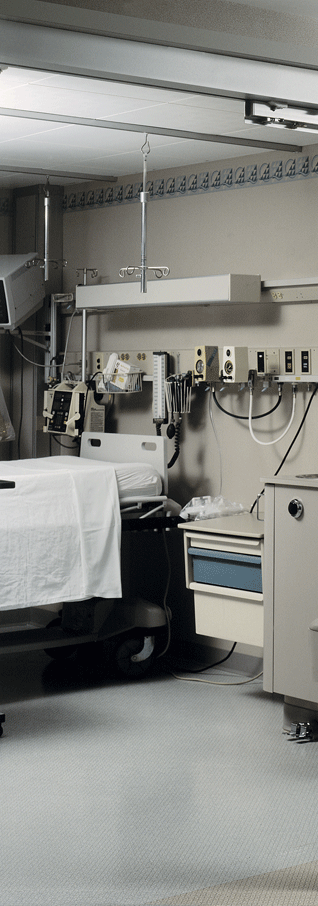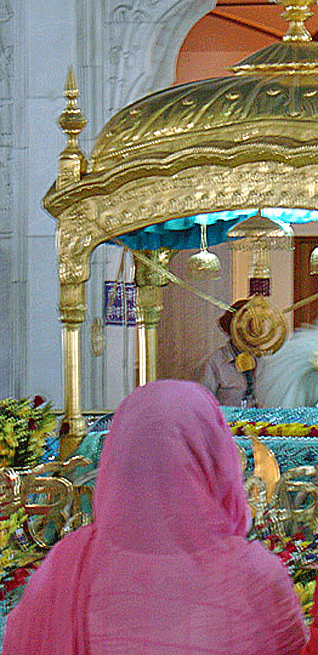Columnists
Working in the ICU
by TEJPREET KAUR
Working in the Intensive Care Unit ("ICU") absorbs me, both mind and soul.
The ICU is not only a sanctuary for those who are critically ill; it is my tent within the camp of caring for others. It has propagated my desire to capture the spirit of the Khalsa: to be selfless, noble, and brave, while in constant meditation of Waheguru.
I am a strong, spirited and optimistic soldier protecting the sick.
My ego, however, is tamed as I see Waheguru's expression in every thought, decision, and action that is made by both myself and other members of the medical team. Although my attending physicians may believe otherwise, I kindly obey the orders of my Guru to assist in both the processes: of restoration to health and of death.
The ICU can be a frightening environment to both young doctors and patients alike; yet, it is a place where miracles often occur and it always manages to tug at my Sikhi heart-strings without fail.
I feel the rhythm of the Khalsa enrapture my senses when I enter the unit. I hear it bounding against me as I make my rounds through each patient's room. I hear it in the beeps of the telemetry monitors and ventilators. I hear it permeate through the chaotic motions of a resuscitation. I hear it softly emerge behind conversations of end-of-life care. I hear it shout gloriously when a person leaves the unit alive and well.
"When the Khalsa runs, he is in trance. On the bed of thorns, he lies on roses. Outside is immaterial; it is the aim of life that matters. The Khalsa is he who has found the centre of life and has enshrined God in the temple of his heart. The Khalsa looks at the world from a supreme height, blessing all, helping all, loving all, with his beautiful looks from the inner self of all life".
[Creation and the Purpose of Khalsa, Puran Singh]
I often yearn to leave my sahajdhari status and live as one of the initiated; this usually reaches its peak when I'm well immersed in the unit.
Recently, however, I have noticed the rhythm of the Khalsa pulsating within my consciousness outside of the ICU as well. Have I entered the sphere of constant remembrance? Has my spirit reawakened and traveled closer to the doors of the court of brotherhood/sisterhood?
I remember singing, as a child, "We are the Khalsa, mighty mighty Khalsa", and wondering whether a modern Sikh could truly invoke Khalsa and live in a similar fashion.
Funny how what was once a fleeting reflection has now evolved into a tangible proposal.
Perhaps feeling the rhythm inside oneself is the first step to realization of its possibility.
February 12, 2008
Conversation about this article
1: Prem Singh (London, England), February 12, 2008, 12:37 PM.
Is Khalsa a state of mind and spiritual oneness or a simple physical uniform? This dissonance troubles me. Why are the outward manifestations emphasised more that internal spiritual unity and peace? And a hierarchy is formed immediately. I know so many men who have worn the Khalsa uniform who have been bad people, and yet their status as Khalsa has blunted all criticism of them. [Editor: How about both elements? - both Form and Substance are necessary ingredients!]
2: I.J. Singh (New York, U.S.A.), February 12, 2008, 5:10 PM.
This reminds me of the classic biologic dictum of "Form & Function". Together, they make a "whole" bigger than the sum of the parts. And then the mind and body flow in unison and in sync. The athlete experiences it, and it can happen in the most mundane activities of life. And this idea is what Tejpreet has beautifully framed for us.
3: Manjyot Kaur (New York City, U.S.A.), February 13, 2008, 2:53 PM.
Tejpreet, the thoughts and feelings you have expressed are lovely ones. Why not consider honoring them - and the Divine Source that placed them in your mind and heart - by starting to accompany them (at your own pace) with some concrete actions? Since you say you "yearn to leave my sahajdhari status and live as one of the initiated", you might want to take steps towards this goal by trying to do Paath on a regular basis, keep Kesh, and perform other such acts commensurate with the Khalsa lifestyle. In this way, you will know whether or not to accept the "tangible proposal" you spoke of.
4: Desh Singh, MD (Houston, Texas, U.S.A.), February 13, 2008, 6:19 PM.
As a Sikh neurosurgeon who spends much of his time managing critically ill ICU patients, I agree that being a Sikh goes hand-in-hand with being able to manage and assume great responsibility. Working in an ICU, like other great responsibilities, reminds us that the quality of our decisions and our deeds matter greatly and that, as Sikhs, we should act in a way where what we aspire to be does not diverge from what we do. Sometimes, when I have not slept for days and am the only neurosurgeon on call at a Level 1 trauma center and a patient with a large subdural hematoma is brought in, it is the reminder that I am a Sikh that pushes me against my fatigue to do everything I can to save the patient's life. Being a Sikh, like being a neurosurgeon, is not for everyone, but if we are willing to live up to great responsibility, nothing is beyond the reach of anyone.
5: Tejwant (U.S.A.), February 14, 2008, 12:21 AM.
Tejpreet, you write, "I often yearn to leave my sahajdhari status and live as one of the initiated; this usually reaches its peak when I'm well immersed in the unit". Well, the most revealing part you have shared in the above heartfelt essay is that you have already intiated yourself from within. You have cultivated your Sikhi spirit, while at the same time being aware that you lack the form that makes you stand out as a Sikh. Well, Tejpreet, the scent of a flower is cultivated within before it can emit itself in all directions sans bias. So, your reverse osmosis does have the Sikhi perfume. The petals will be formed by the inner nurturing that you have already started. This process does need sehaj ...
6: Dr.T.J. Singh (India), February 14, 2008, 1:00 PM.
Many thanks to Tejpreet Kaur for such a beautiful article with wonderfully articulate sentiments. I also work as a resident in neuro ICU with patients with severe head trauma or post operated cases, all maintained on ventilators and ionotropic support. With all the monitors and ventilators beeping in the mind and as a doctor wanting to ensure the best outcomes possible for my patients, I can't focus on the backgrounds, ethnic identities, or even the faces of the patients there, except just names on the treatment chart - and I seek to serve them all with the same care and affection. When the majority among them rally enough to be discharged and return for regular follow-up in the outpatient department, I hardly recognise their faces and can only focus on why they are there. Many patients remember me closely and try to remain in contact, long after they have been healed. This is what the Khalsa - and serving humanity without differentiation means - and so I, too, am a sehajdhari, but do wear turban, though I may not think of it in those terms every day. We, in the medical community, though many do not consider it, begin with privilege, starting with the gift of education. It is only natural that we use those gifts of education and privilege to serve others and to ensure public health and safety.
7: Bhupinder Singh Ghai (New Delhi, India), February 15, 2008, 1:35 AM.
I am humbled by Tejpreet's story. I guess the rhythm that she is mentioning is like the feeling of ecstasy, the anhad naad. Isn't Sikhi all about this? You can be in sync with God in any situation, within any profession or vocation, and in most doing the most mundane of chores. You just have to listen to this divine rhythm.
8: Satvir Kaur (Boston, U.S.A.), February 22, 2008, 8:55 AM.
I am delighted ... wonderful! Liked reading it for the second time. Khalsa is both form and substance. Sadly, I only took form and am still fighting for some substance. It's inspiring to see people who have the feeling and then take the form.
9: Satwinder Singh (Dublin, Ireland), February 25, 2008, 8:54 AM.
Both the article and comments have very powerful reflections. The observation that both "form and substance" are inherent to being a Khalsa, couldn't have been more on point. However, many of us struggle to strike a balance between the two. Lack of substence within us has lead to the lack of respect for the importance of form. Form [bana - but not in the current, oft-distorted sense] is a testimony of Substance (character) within us. Our reluctance/unwillingness to understand that has lead us to do things which are unbecoming of us as Sikhs. This seeming "contradiction" in Form & Substance is very confusing to many young Sikhs.
10: Izhaarbir Singh (Houston, Texas, U.S.A.), July 12, 2011, 2:46 AM.
Beautiful thoughts. Thank you for sharing the inspiration.




